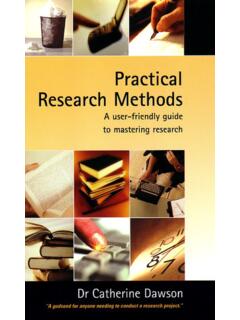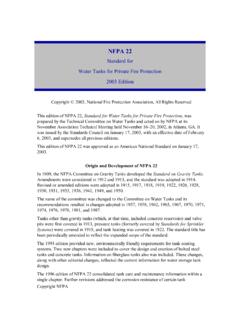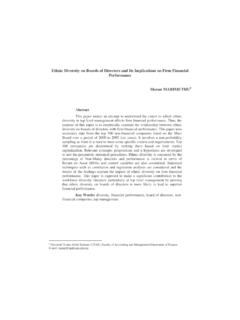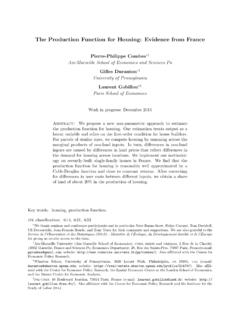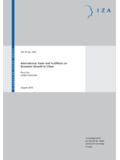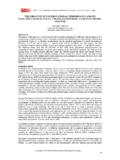Transcription of Copyright © 2004, 1990, 1985, New Age International (P ...
1 Copyright 2004, 1990, 1985, New Age International (P) Ltd., PublishersPublished by New Age International (P) Ltd., PublishersAll rights part of this ebook may be reproduced in any form, by photostat, microfilm,xerography, or any other means, or incorporated into any information retrievalsystem, electronic or mechanical, without the written permission of the inquiries should be emailed to FOR ONE WORLDNEW AGE International (P) LIMITED, PUBLISHERS4835/24, Ansari Road, Daryaganj, New Delhi - 110002 Visit us at (13) : 978-81-224-2488-1In loving memory ofmy revered father(The fountain of inspiration)Preface to the Second EditionviiPreface to the Second EditionI feel encouraged by the widespread response from teachers and students alike to the first edition.
2 Iam presenting this second edition, thoroughly revised and enlarged, to my readers in all possible efforts have been made to enhance further the usefulness of the book. The feedbackreceived from different sources has been this edition a new chapter on The Computer: Its role in research have been added in viewof the fact that electronic computers by now, for students of economics, management and othersocial sciences, constitute an indispensable part of research other highlights of this revised edition are (i) the subject contents has been developed,refined and restructured at several points, (ii) several new problems have also been added at the endof various chapters for the benefit of students, and (iii) every page of the book has been read verycarefully so as to improve its am grateful to all those who have helped me directly and/or indirectly in preparing this revisededition.
3 I firmly believe that there is always scope for improvement and accordingly I shall lookforward to received suggestions, (which shall be thankfully acknowledged) for further enriching thequality of the KOTHARIMay 1990 Preface to the First EditionixPreface to the First EditionQuite frequently these days people talk of research , both in academic institutions and outside. Severalresearch studies are undertaken and accomplished year after year. But in most cases very littleattention is paid to an important dimension relaing to research , namely, that of research result is that much of research , particularly in social sciences, contains endless word-spinningand too many quotations. Thus a great deal of research tends to be futile.
4 It may be noted, in thecontext of planning and development, that the significance of research lies in its quality and not inquantity. The need, therefore, is for those concerned with research to pay due attention to designingand adhering to the appropriate methodology throughout for improving the quality of research . Themethodology may differ from problem to problem, yet the basic approach towards research remainsthe all this in view, the present book has been written with two clear objectives, viz., (i) toenable researchers, irrespective of their discipline, in developing the most appropriate methodologyfor their research studies; and (ii) to make them familiar with the art of using different research -methods and techniques. It is hoped that the humble effort made in the form of this book will assist inthe accomplishment of exploratory as well as result-oriented research the organization, the book consists of fourteen chapters, well arranged in a coherentmanner.
5 Chapter One is an introduction, presenting an overview of the research methodology . ChapterTwo explains the technique of defining a research problem. Chapter Three dwells on various researchdesigns, highlighting their main characteristics. Chapter Four presents the details of several samplingdesigns. Different measurement and scaling techniques, along with multidimensional scaling, havebeen lucidly described in Chapter Five. Chapter Six presents a comparative study of the differentmethods of data collection. It also provides in its appendices guidelines for successful interviewing aswell as for constructing questionnaire/schedules. Chapter Seven deals with processing and analysisof data. Sampling fundamentals, along with the theory of estimation, constitutes the subject-matter ofChapter Eight.
6 Chapter Nine has been exclusively devoted to several parametric tests of hypotheses,followed by Chapter Ten concerning Chi-square test. In Chapter Eleven important features of ANOVAand ANOCOVA techniques have been explained and illustrated. Important non- parametric tests,generally used by researchers have been described and illustrated in Chapter Twelve. In ChapterThirteen, an effort has been made to present the conceptual aspects and circumstances under whichxPreface to the First Editionvarious multivariate techniques can appropriate be utilized in research studies, specially in behaviouraland social sciences. Factor analysis has been dealt with in relatively more detail. Chapter Fourteenhas been devoted to the task of interpretation and the art of writing research book is primarily intended to serve as a textbook for graduate and students ofResearch methodology in all disciplines of various universities.
7 It is hoped that the book shall provideguidelines to all interested in research studies of one sort or the other. The book is, in fact, anoutgrowth of my experience of teaching the subject to students for the last several am highly indebted to my students and learned colleagues in the Department for providing thenecessary stimulus for writing this book. I am grateful to all those persons whose writings and workshave helped me in the preparation of this book. I am equally grateful to the reviewer of the manuscriptof this book who made extremely valuable suggestions and has thus contributed in enhancing thestandard of the book. I thankfully acknowledge the assistance provided by the University GrantsCommission in the form of on account grant in the preparation of the manuscript of this shall feel amply rewarded if the book proves helpful in the development of genuine researchstudies.
8 I look forward to suggestions from all readers, specially from experienced researchers andscholars for further improving the subject content as well as the presentation of this KOTHARIC ontentsxiContentsPreface to the Second EditionviiPreface to the First Editionix1. research methodology : An Introduction1 Meaning of Research1 Objectives of Research2 Motivation in Research2 Types of Research2 research Approaches5 Significance of Research5 research Methods versus Methodology7 research and Scientific Method9 Importance of Knowing How research is Done10 research Process10 Criteria of Good Research20 Problems Encountered by Researchers in India212. Defining the research Problem24 What is a research Problem?24 Selecting the Problem25 Necessity of Defining the Problem26 Technique Involved in Defining a Problem27An Illustration29 Conclusion293.
9 research Design31 Meaning of research Design31 Need for research Design32xiiResearch MethodologyFeatures of a Good Design33 Important Concepts Relating to research Design33 Different research Designs35 Basic Principles of Experimental Designs39 Conclusion52 AppendixDeveloping a research Plan534. Sampling Design55 Census and Sample Survey55 Implications of a Sample Design55 Steps in Sampling Design56 Criteria of Selecting a Sampling Procedure57 Characteristics of a Good Sample Design58 Different Types of Sample Designs58 How to Select a Random Sample?60 Random Sample from an Infinite Universe61 Complex Random Sampling Designs62 Conclusion675. Measurement and Scaling Techniques69 Measurement in Research69 Measurement Scales71 Sources of Error in Measurement72 Tests of Sound Measurement73 Technique of Developing Measurement Tools75 Scaling76 Meaning of Scaling76 Scale Classification Bases77 Important Scaling Techniques78 Scale Construction Techniques826.
10 Methods of Data Collection95 Collection of Primary Data95 Observation Method96 Interview Method97 Collection of Data through Questionnaires100 Collection of Data through Schedules104 Difference between Questionnaires and Schedules104 Some Other Methods of Data Collection106 Collection of Secondary Data111 ContentsxiiiSelection of Appropriate Method for Data Collection112 Case Study Method113 Appendices(i) Guidelines for Constructing Questionnaire/Schedule11 8(ii)Guidelines for Successful Interviewing11 9(iii)Difference between Survey and Experiment1207. Processing and Analysis of Data122 Processing Operations122 Some Problems in Processing129 Elements/Types of Analysis130 Statistics in Research131 Measures of Central Tendency132 Measures of Dispersion134 Measures of Asymmetry (Skewness)136 Measures of Relationship138 Simple Regression Analysis141 Multiple Correlation and Regression142 Partial Correlation143 Association in Case of Attributes144 Other Measures147 Appendix: Summary Chart Concerning Analysis of Data1518.
